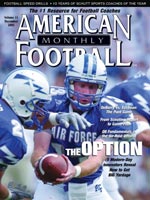AMERICAN FOOTBALL MONTHLY THE #1 RESOURCE FOR FOOTBALL COACHES
Article CategoriesAFM Magazine
|
True Football Speedby: Danny Arnold© More from this issue We can all agree, speed is one of the most important factors in football. And in recent years we have seen a huge increase in the availability to many effective and productive speed and plyometric training workouts. Unfortunately, most of these workouts are made to increase linear speed and not true football speed (TFS), a multi-directional, non-consistent type of speed that is determined by reaction to someone or something. In this article, I will illustrate plyometrics specifically designed for football players that combined with your current speed development program, will help your players attain TFS. Before we begin, let’s understand the basic theory behind plyometrics. Plyometric training is the stretch-shortening cycle when an explosive movement is done. As the muscle stretches and contracts eccentrically (le....The full article can only be seen by subscribers. Subscribe today!
|
|
|||||||
| HOME |
MAGAZINE |
SUBSCRIBE | ONLINE COLUMNISTS | COACHING VIDEOS |
Copyright 2025, AmericanFootballMonthly.com
All Rights Reserved





